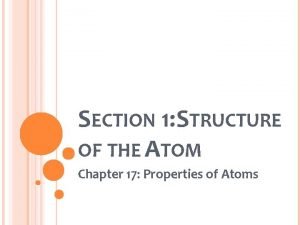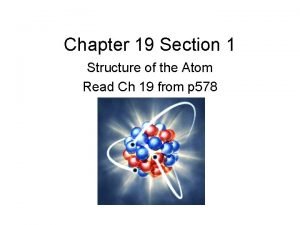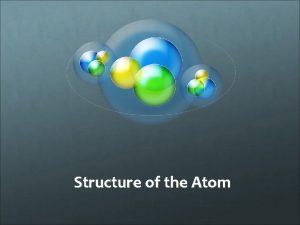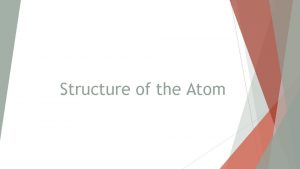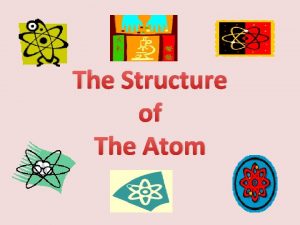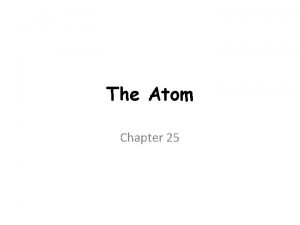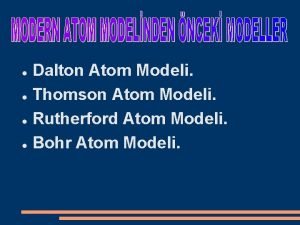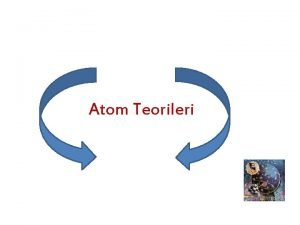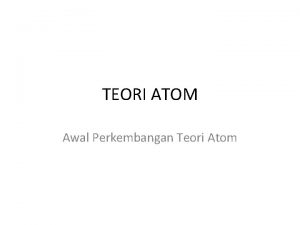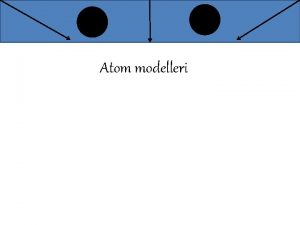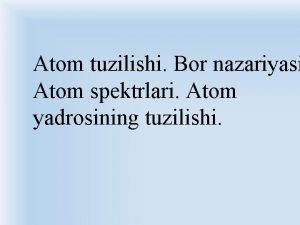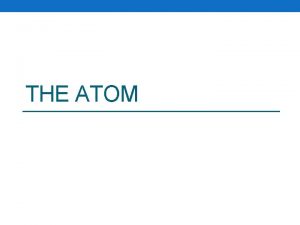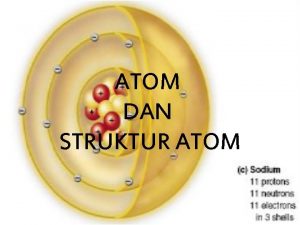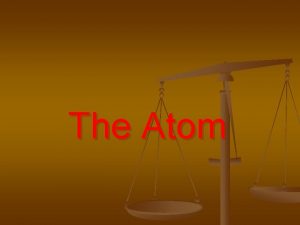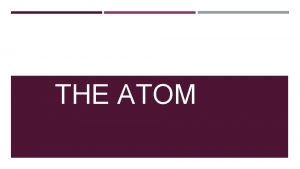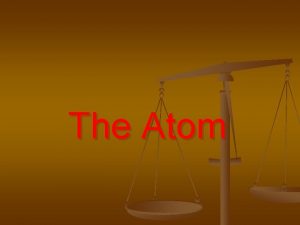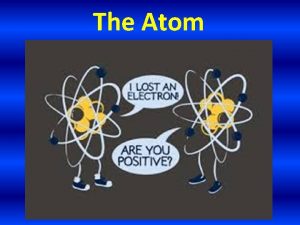Chapter 19 Section 1 Structure of the Atom
















































- Slides: 48

Chapter 19 Section 1 Structure of the Atom Read Ch 19 from p 578

Scientific Shorthand • Scientists abbreviate the names of elements – Each element has a nickname • 1, 2 or sometimes 3 letters • First letter capitalized • Second and third letter would be lower case • Names of elements come from different sources – – – Latin names Honoring scientists Places Properties of the element Rules established by an international committee



Chemical Formulas

Atomic Components • The atom is made up of different parts – Protons • Large particles, found in nucleus • Positively charged – Neutrons • Large particles, found in nucleus • No charge – Electrons • Tiny particles, found outside of nucleus • Negatively charged

Quarks • Theorized particles that make up protons and neutrons – 6 different quarks have been discovered • The theory is that an arrangement of 3 quarks held together with a strong nuclear force produces a proton • The search for the components of protons and neutrons is an ongoing effort • Atomic Particles

Finding Quarks • To study quarks, scientists accelerate charged particles to tremendous speeds and then force them to smash into protons • Electric and magnetic fields are used to accelerate, focus, and smash the particles. • This causes the proton to break apart. • Particles from the collision are detected and reconstructed like crime scene data.

Models • There have been many changes to the model of the atom over history • It was not always known that all matter was composed of atoms – Aristotle disputed Democritus’ theory that matter is composed of smaller particles

Democritus Model • Atom could not be subdivided – Named it atomos, meaning uncuttable

John Dalton • Dalton offered proof that the atom existed • Dalton’s model was similar to Democritus • Dalton’s ideas gave a physical explanation for chemical reactions

Thomson Model - 1904 • Electrons embedded in a positively charged sphere • Called the plum pudding model.

Rutherford Gold Foil Demonstration • Click on the following: • https: //www. youtube. com/watch? v=XBq. Hk raf 8 i. E

Rutherford Model - 1911 • Almost all the mass of the atom in the center of the atom • All positive charge in the center of the atom

Bohr Model - 1913 • Electrons travel in fixed orbits around the nucleus of the atom. • Chadwick concluded that the nucleus contained positive protons and neutral neutrons.

Electron Cloud Model - Current

Electron Cloud Model - 1926 • Electron Cloud is the area around the nucleus where electrons are likely found. • Electron Cloud is 100, 000 times larger than the diameter of the nucleus. Imagine a baseball field. An orange at the pitcher’s mound would be the nucleus and the rest of the field would be the electron cloud. • Electrons are moving so fast they are like spokes on a moving bicycle wheel.


Compare Protons and Neutrons Protons 1. 2. 3. 4. Large particles Notes 5. Compare Protons/Neutrons 1. 2. 3. 4. Large particles Notes

Venn Diagram Proton Electron Neutron


Ch 19. 1 Analysis: 1 paragraph 1. List chemical symbols for the elements carbon, aluminum, sodium, and sulfur. 2. Identify the names, charges, and location of the 3 main kinds of particles in an atom 3. Identify the smallest particle of matter. How were they discovered? 4. Describe the electron cloud model of the atom.

Chapter 19 Section 2 Masses of Atoms

Atomic Mass • Atomic Mass = mass of an atom • Unit of measurement is the amu – 1 amu (Atomic Mass Unit) is almost equal to the mass of a single proton or neutron • Protons and neutrons are far more massive than electrons

Atomic Number • Atomic Number = number of protons in an element • To keep atoms neutrally charged, number of protons equals the number of electrons • So, Atomic Number = number of protons = number of electrons

Mass Number • The Mass Number can be used to find the number of neutrons in an element. – Mass Number = sum of protons and neutrons – Neutrons = Mass Number – Atomic Number

Isotopes • Not all atoms have the same number of neutrons • Atoms of the same element with different numbers of neutrons are called isotopes • If there is a different number of neutrons, the mass number will be different

Identifying Isotopes • Average atomic mass is the weighted average mass of the mixture of isotopes – This is why mass number is not usually a whole number • A number is given to identify different isotopes – Like Boron-10 and Boron-11

Periodic Table of Elements • Organized chart of the elements • Elements are in order by atomic number • Also arranged by differences in physical and chemical properties • Groups or Families in vertical columns have elements with similar properties. • Periods are in horizontal rows.

Dmitri Mendeleev • Father of the periodic table noticed trends in elements that were periodic, or repeated. • Arranged the first periodic table by atomic mass in 1869. • Left blanks for missing elements AND predicted their properties.


Henry Mosely • Mosely made some changes to the periodic table • He arranged all atoms by increasing atomic numbers instead of atomic masses


Electron Cloud Structure • Electrons within the electron cloud have different amounts of energy – The closer an electron is to the nucleus, the less energy it has. • Elements in a group have same number of electrons in the outer valence energy level – This determines properties of the elements

Electron Dot Diagram • The outer shell is important in determining chemical properties of elements. • Electron dot structures use dots around the symbols of the elements to represent the electrons in the outer shell. • Electron dot structures can also be used to show elements bond.

Valence Electrons • Valence electrons are the electrons in the highest occupied energy level of the atom. Usually they are in the outer shell. • Valence electrons are the only electrons generally involved in bond formation.

Groups and Periods • Each element in a Group or Family column has the same number of valence electrons in their outer energy level. • Generally, each Period row represents an energy level where electrons may be found

Energy Levels 1 – 7 (p 592) • Atoms want to be stable by filling their electron energy levels. • The 1 st energy level nearest the nucleus may contain a maximum of 2 electrons. • The 2 nd and 3 rd energy levels may contain a maximum of 8 electrons. • Beyond that, energy levels may contain 18 or even 32 electrons.

Lewis Electron Dot Diagram • A Dot Diagram simply shows valence electrons around the element symbol.

Create Dot Diagrams • Find the Group column the element is in. • This tells the number of valence electrons. • Write the symbol and then draw valence electrons around it, starting at 3 o’clock and going counterclockwise to 12, 9, & 6. Continue around one more time if needed. • Draw dot diagrams for Cl and C.

Dot Diagram Solution 1 • Chlorine and Carbon should look like this:

Dot Problem 2 • Use the Periodic Table to find the number of valence electrons to complete the chart. • Draw the chart, symbols and dots needed. Follow pattern above starting at position 1. 1 A 2 A 3 A 4 A 5 A 6 A 7 A H 8 A He Li Be B C N O F Ne Na Mg Al Si P S Cl Ar K Ca Ga Ge As Se Br Kr

Dot Diagram Solution 2 • Elements in the same Group have the same valence electron dot structure.

Dot Diagrams for Bonds • A chemical bond might looks like this:

Definitions • Alloy: solid solution (mixture) of metals • Aluminum: most abundant metal in Earth’s crust • Conductive: able to transfer materials like heat (thermal) and electricity easily • Ductile: able to be stretched (drawn) into wire • Ion: charged atom from electrons gained or lost • Luster: shiny and able to reflect light • Malleable: able to be shaped by hammer • Oxidation: rust caused by reacting with oxygen • Oxygen: most abundant element in Earth’s crust

Helpful Tips • A# = Por. E: Atomic Number = Protons or Electrons • No. P = E: Number of Protons = Electrons • Pa. N = Ma. N: Protons and Neutrons = Mass Number

Ch 19. 2 Analysis: Make Tables 1. Use Periodic Table to find the name, atomic number, and atomic mass of the following elements: N, Ca, Kr, and W. 2. List the period and group where these elements are found: nitrogen, sodium, iodine, and mercury. 3. Give the name & classify each as metal, nonmetal, or a metalloid: K, Si, Ba, and S. See tables on next slide.

Ch 19. 2 Analysis: Draw & Complete Tables Symbol Name Atom Number Atom Mass N 1. Ca Kr W Name 2. Period ↔ Row Group ↨ Column Nitrogen Sodium Iodine Mercury Symbol 3. K Si Ba S Name Metal Non-Metalloid
 The structure of the atom section 2 defining the atom
The structure of the atom section 2 defining the atom Section 1 structure of the atom
Section 1 structure of the atom Section 1 structure of the atom
Section 1 structure of the atom Teori democritus
Teori democritus Chapter 10 meiosis 1 and meiosis 2
Chapter 10 meiosis 1 and meiosis 2 Electrons in atoms section 2 quantum theory and the atom
Electrons in atoms section 2 quantum theory and the atom Electrons in atoms section 2 quantum theory and the atom
Electrons in atoms section 2 quantum theory and the atom Hát kết hợp bộ gõ cơ thể
Hát kết hợp bộ gõ cơ thể Lp html
Lp html Bổ thể
Bổ thể Tỉ lệ cơ thể trẻ em
Tỉ lệ cơ thể trẻ em Gấu đi như thế nào
Gấu đi như thế nào Chụp tư thế worms-breton
Chụp tư thế worms-breton Bài hát chúa yêu trần thế alleluia
Bài hát chúa yêu trần thế alleluia Kể tên các môn thể thao
Kể tên các môn thể thao Thế nào là hệ số cao nhất
Thế nào là hệ số cao nhất Các châu lục và đại dương trên thế giới
Các châu lục và đại dương trên thế giới Công thức tính độ biến thiên đông lượng
Công thức tính độ biến thiên đông lượng Trời xanh đây là của chúng ta thể thơ
Trời xanh đây là của chúng ta thể thơ Mật thư tọa độ 5x5
Mật thư tọa độ 5x5 Phép trừ bù
Phép trừ bù Phản ứng thế ankan
Phản ứng thế ankan Các châu lục và đại dương trên thế giới
Các châu lục và đại dương trên thế giới Thơ thất ngôn tứ tuyệt đường luật
Thơ thất ngôn tứ tuyệt đường luật Quá trình desamine hóa có thể tạo ra
Quá trình desamine hóa có thể tạo ra Một số thể thơ truyền thống
Một số thể thơ truyền thống Cái miệng nó xinh thế
Cái miệng nó xinh thế Vẽ hình chiếu vuông góc của vật thể sau
Vẽ hình chiếu vuông góc của vật thể sau Nguyên nhân của sự mỏi cơ sinh 8
Nguyên nhân của sự mỏi cơ sinh 8 đặc điểm cơ thể của người tối cổ
đặc điểm cơ thể của người tối cổ Ví dụ giọng cùng tên
Ví dụ giọng cùng tên Vẽ hình chiếu đứng bằng cạnh của vật thể
Vẽ hình chiếu đứng bằng cạnh của vật thể Fecboak
Fecboak Thẻ vin
Thẻ vin đại từ thay thế
đại từ thay thế điện thế nghỉ
điện thế nghỉ Tư thế ngồi viết
Tư thế ngồi viết Diễn thế sinh thái là
Diễn thế sinh thái là Dot
Dot Thế nào là số nguyên tố
Thế nào là số nguyên tố Tư thế ngồi viết
Tư thế ngồi viết Lời thề hippocrates
Lời thề hippocrates Thiếu nhi thế giới liên hoan
Thiếu nhi thế giới liên hoan ưu thế lai là gì
ưu thế lai là gì Hổ đẻ mỗi lứa mấy con
Hổ đẻ mỗi lứa mấy con Khi nào hổ con có thể sống độc lập
Khi nào hổ con có thể sống độc lập Sơ đồ cơ thể người
Sơ đồ cơ thể người Từ ngữ thể hiện lòng nhân hậu
Từ ngữ thể hiện lòng nhân hậu Thế nào là mạng điện lắp đặt kiểu nổi
Thế nào là mạng điện lắp đặt kiểu nổi

